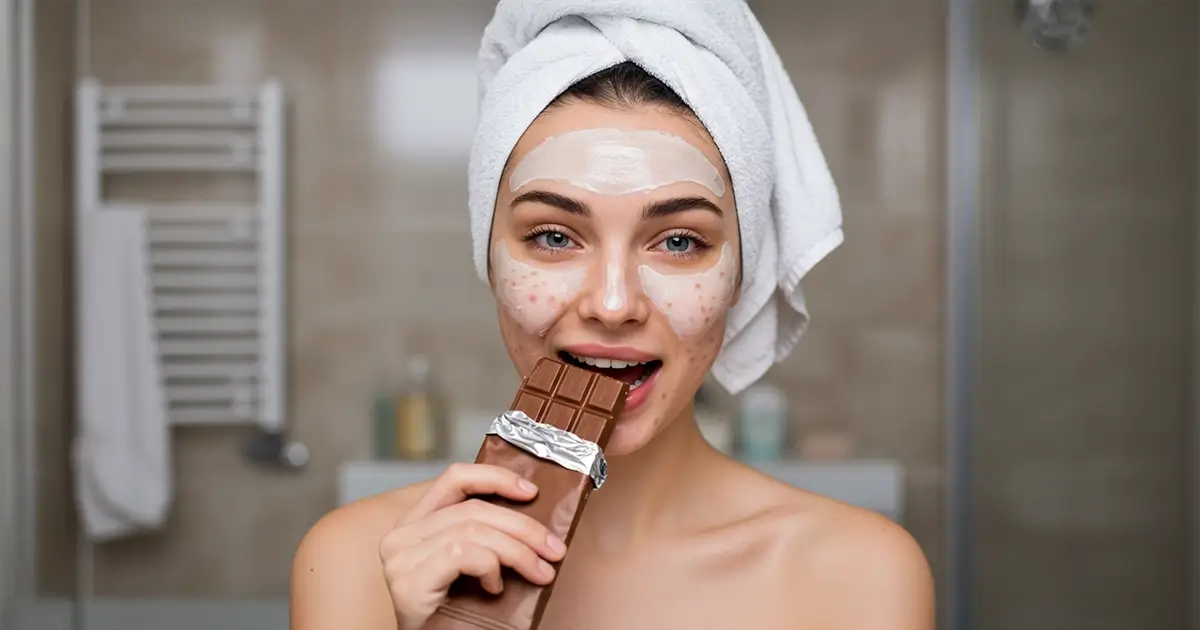Chocolate and pimples have been gossiped about for decades, yet the science keeps shapeshifting under our noses. Today I break down the latest studies, untangle myths, and hand you practical tips in one sweet, clear-skinned package - 10-minute read.
The Birth of a Skin Myth
Back in the 1920s, before anyone could spell "randomized controlled trial," doctors began warning teens that a chocolate bar would sprout a spot faster than you could say cocoa. Their advice stuck because it felt logical: oily treat, oily skin. Logical, however, is not always factual.
By the 1960s scientists finally tested the idea, but early experiments used tiny sample groups and low-cocoa candies mixed with sugar and milk. The headline "Chocolate Not Guilty" travelled the world, even though the data were flimsy and the follow-up period laughably short. Parents cheered, dermatologists sighed, and teens kept unwrapping foil without fear.
Fast-forward to social media. Personal anecdotes returned with a vengeance: "I ditch chocolate, my chin clears overnight!" Stories spread quicker than a reel, turning shaky evidence into modern folklore. I get it - nothing bonds people like breakout confessions, but anecdotes need lab coats to become knowledge.
In short, the myth was born not from villainous cocoa beans but from a cocktail of small studies, sugar confounders, and the irresistible pull of a simple cause-and-effect story.
What the Modern Studies Actually Show
Newer trials finally isolated chocolate itself. A crossover study gave participants 85 % dark bars every day for four weeks and found a measurable uptick in pustules and papules. The effect was modest - hardly an overnight volcanic eruption - but statistically real.
An even more controlled experiment tracked young men who swallowed pure cocoa capsules (no sugar, no dairy). Lesions increased within 48 hours, hinting that certain bioactive compounds may tweak inflammation directly. That surprised many dermatologists who had blamed sugary add-ins rather than cocoa.
Balanced against these are papers that found no difference between milk-chocolate eaters and placebo groups. A systematic review in Dermatology Research and Practice concluded that results remain inconsistent, although diets high in sugar and dairy stand out as clearer culprits. Such nuance rarely fits into a meme.
Cocoa Content Matters
Very dark bars pack more flavonoids, which can act as antioxidants or pro-oxidants depending on dose. When volunteers consumed 99 % cocoa, sebum oxidation rose, creating an environment where C. acnes thrives. Milk versions, oddly, fared a bit better in that narrow biochemical snapshot.
That said, milk chocolate delivers extra sugar and whey proteins, both linked to insulin spikes. High insulin stimulates androgen pathways, androgens boost sebum, and sebum feeds breakouts. In practice, the darker bar may irritate through flavonoid overload, while the lighter bar may irritate through sugar chaos. Pick your poison, right? Don't worry - practical tips are coming.
Sugar and Dairy Confounders
Most supermarket chocolate features refined sugar among the first two ingredients. Sugar rockets glycemic load, pushing insulin and IGF-1 hormones that crank oil glands into overdrive. Add milk, rich in bovine growth factors, and you have a double whammy.
Researchers who controlled for sugar and dairy discovered that cocoa alone still nudged inflammatory markers but to a smaller extent. Translation: if you already follow a low-glycemic plan, a square of dark chocolate is less risky than a candy bar washed down with a milkshake.
How Chocolate Could Influence Acne Biology
Let's zoom inside the pore. Cocoa powder is loaded with theobromine and caffeine. Both can dilate blood vessels and potentially increase nutrient flow to sebaceous glands. More nutrients can mean more sebum, though the evidence here is early-stage.
Flavonoids such as epicatechin may switch on NF-κB pathways when present at high concentrations. NF-κB orchestrates pro-inflammatory cytokines. Inflammation is the flame that turns clogged pores into visible acne. The same compounds are heart-friendly in moderate doses, showing that dose and context rule everything.
Then there is oxidation. When sebum oxidises, it becomes sticky and comedogenic. Certain polyphenols in cocoa can paradoxically accelerate lipid peroxidation under bright light. Sunscreen helps, and yes, I plug SPF in every post - if you missed my guide on comprehensive sun care, peek at Sun Protection Essentials next.
Gut-Skin Axis Again
Chocolate, especially with sweeteners, may alter gut microbiota toward species that produce endotoxins. Endotoxins leak into circulation, set off systemic inflammation, and the skin often shows first because it is an immune organ in plain sight.
Probiotic intervention studies suggest that a fortified yoghurt can balance gut changes caused by high-sugar treats. The science is young, yet the pattern repeats: whole-food context matters more than one glamorous ingredient.
Stress, Cravings, and Hormones
I don't know about you, but when I'm stressed my fingers reach for chocolate automatically. Cortisol rises, blood sugar wobbles, androgens surge, pores protest. The treat itself is only half the story; the emotional backdrop completes the breakout picture. Quick meditation or a mini walk often cools cravings before they boss your skin around.
Practical Tips for Enjoying Chocolate Without Breakouts
Derm lectures can feel preachy, so here's a girlfriend checklist you can actually tape to the fridge:
- Choose chocolate that lists cocoa mass first, sugar second, milk never. Aim for 70 % cacao or higher, one square at a time.
- Pair it with fibre - think almonds or raspberries - to blunt the glycemic swing.
- Eat your square after a protein-rich meal, not on an empty stomach.
- Drink water, not soda or sweet lattes, alongside it.
- Keep fingers clean; wiping melted chocolate onto your cheek is a guaranteed breakout in disguise.
Bonus laugh: if a square melts on your laptop, resist licking the keyboard. Studies show germs there rival a subway pole. Yes, that's my one joke; I promise the rest is peer-reviewed.
Finally, track your own skin journal. Some people flare within 24 hours, while others munch blissfully. Personal data beats one-size-fits-all rules.
Lifestyle and Diet Factors That Overshadow Chocolate
High-glycemic staples - white bread, sugary drinks - produce stronger insulin spikes than any chocolate bar. Swap them for quinoa, oats, or legumes and you remove a major driver of hormonal sebum.
Lack of sleep raises cortisol and inflammatory cytokines. Seven hours might sound like a luxury, yet it is cheaper than prescription retinoids. I keep a boring wind-down routine, chamomile tea included, and my skin thanks me with calm mornings.
Don't skip basics: gentle cleanser, non-comedogenic moisturiser, broad-spectrum SPF. When your barrier is intact, tiny dietary triggers have less chance to tip the balance.
Exercise improves insulin sensitivity. Forty brisk minutes three times a week lowers circulating IGF-1, meaning fewer oil gland tantrums. Sweat does not cause acne if you shower promptly.
Reading Labels Like a Derm Detective
Ingredient lists hide behind marketing front lines. If the first two ingredients are sugar and palm oil, put the bar back. Cocoa butter should appear higher than any substitute fat.
Watch for whey powder, casein, or skim milk solids. These supply leucine and other amino acids that stimulate mTOR, a pathway already hyperactive in acne-prone folks.
Flavour markers such as caramel, cookie crumble, or crispy rice add more refined carbs. Think of them as little Trojan horses sneaking extra sugar into your snack. The simpler the bar, the easier your skin detective work.
Consider portion sizes clearly labelled in grams. Many premium bars break into 10-gram squares, which makes mindful eating mechanical: one square, break, savour, done.
FAQ
Does white chocolate affect acne differently from dark chocolate?
White chocolate lacks cocoa solids, yet it is heavy in sugar and dairy proteins. Those two increase insulin and IGF-1 more than pure cocoa, so white bars may spark breakouts even faster.
Can cocoa powder in a smoothie cause acne?
Unsweetened cocoa contains bioactive compounds, but in small smoothie doses it rarely causes trouble. Watch the sweeteners and dairy in the shake instead.
Is carob a safe chocolate substitute for acne-prone skin?
Carob is naturally sweet and caffeine-free, with lower fat. Early reports suggest it has minimal effect on androgen or insulin pathways, making it a gentler alternative, though peer-reviewed data remain scarce.
How soon after eating chocolate might pimples appear?
Studies using pure cocoa noted lesion counts rising within 24–48 hours, yet individual timelines vary. Keeping a food-skin diary is your best timing tool.
Do topical chocolate facials clog pores?
Most spa "chocolate masks" use cocoa butter, a highly occlusive fat. If you are acne-prone, skip them or do a patch test on your jaw first.
Will switching to vegan dark chocolate solve my acne?
Removing dairy cuts one trigger, but sugar and high-dose flavonoids can still inflame. Vegan bars are gentler yet not a magic shield; moderation remains key.
Conclusion
The verdict is nuanced. Pure cocoa can nudge inflammation and sebum, while sugar and dairy magnify the effect. Genetics, hormones, and lifestyle weigh far more than a single dessert.
Experiment mindfully, log your findings, and remember that skin care is a marathon of small choices. See you in the next post - until then, take good care of your skin!


Comments (0)
No comments yet - be the first to share your thoughts!
Leave a Reply
Your email address will not be published. Required fields are marked *